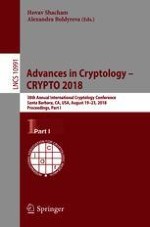2018 | OriginalPaper | Buchkapitel
Provable Security of (Tweakable) Block Ciphers Based on Substitution-Permutation Networks
verfasst von : Benoît Cogliati, Yevgeniy Dodis, Jonathan Katz, Jooyoung Lee, John Steinberger, Aishwarya Thiruvengadam, Zhe Zhang
Erschienen in: Advances in Cryptology – CRYPTO 2018
Aktivieren Sie unsere intelligente Suche, um passende Fachinhalte oder Patente zu finden.
Wählen Sie Textabschnitte aus um mit Künstlicher Intelligenz passenden Patente zu finden. powered by
Markieren Sie Textabschnitte, um KI-gestützt weitere passende Inhalte zu finden. powered by
